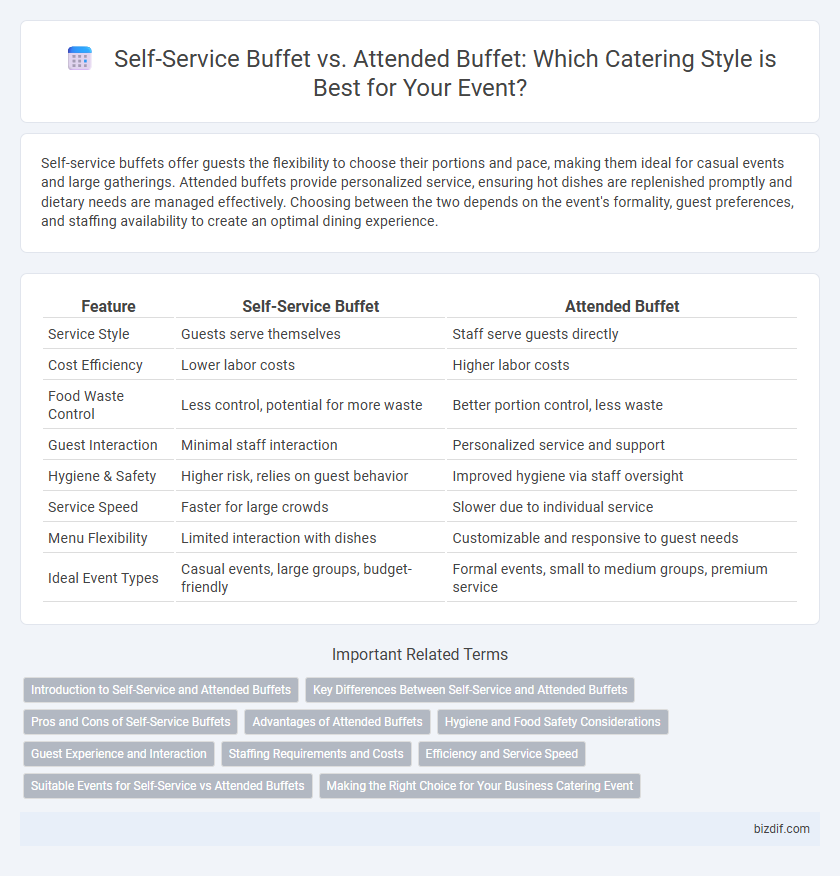Self-service buffets offer guests the flexibility to choose their portions and pace, making them ideal for casual events and large gatherings. Attended buffets provide personalized service, ensuring hot dishes are replenished promptly and dietary needs are managed effectively. Choosing between the two depends on the event's formality, guest preferences, and staffing availability to create an optimal dining experience.
Table of Comparison
| Feature | Self-Service Buffet | Attended Buffet |
|---|---|---|
| Service Style | Guests serve themselves | Staff serve guests directly |
| Cost Efficiency | Lower labor costs | Higher labor costs |
| Food Waste Control | Less control, potential for more waste | Better portion control, less waste |
| Guest Interaction | Minimal staff interaction | Personalized service and support |
| Hygiene & Safety | Higher risk, relies on guest behavior | Improved hygiene via staff oversight |
| Service Speed | Faster for large crowds | Slower due to individual service |
| Menu Flexibility | Limited interaction with dishes | Customizable and responsive to guest needs |
| Ideal Event Types | Casual events, large groups, budget-friendly | Formal events, small to medium groups, premium service |
Introduction to Self-Service and Attended Buffets
Self-service buffets allow guests to serve themselves from a variety of dishes arranged for easy access, promoting convenience and a faster dining experience. Attended buffets feature staff members who assist guests by serving food, maintaining presentation, and ensuring portion control to enhance service quality. Choosing between self-service and attended buffets depends on factors like event size, guest preferences, and desired level of service.
Key Differences Between Self-Service and Attended Buffets
Self-service buffets allow guests to freely select and serve their own food, promoting customization and faster throughput but requiring clear signage and layout for smooth flow. Attended buffets involve staff serving dishes, ensuring portion control and maintaining hygiene standards while offering personalized assistance and interaction. Key differences include guest autonomy, service speed, food presentation, and requirements for staffing and space management.
Pros and Cons of Self-Service Buffets
Self-service buffets offer guests the freedom to choose and control portion sizes, reducing food waste and allowing for a diverse selection tailored to varied preferences. However, they can lead to longer wait times during peak hours and may require more space and frequent replenishment to maintain presentation and hygiene standards. Staffing needs are lower than attended buffets, but the lack of personalized service might affect the overall guest experience.
Advantages of Attended Buffets
Attended buffets provide personalized service, ensuring food is replenished promptly and portions are controlled to reduce waste. Trained staff enhance the dining experience through interaction and presentation, catering to guests' specific dietary needs and preferences. This format promotes hygiene and safety by minimizing guest contact with food, improving overall event quality.
Hygiene and Food Safety Considerations
Self-service buffets pose higher risks for cross-contamination and require stringent hygiene protocols, such as frequent hand sanitizer stations and utensil replacements, to maintain food safety standards. Attended buffets enable staff to monitor portion sizes, prevent direct hand contact with food, and quickly address potential contamination, ensuring a cleaner serving environment. Both buffet styles demand strict temperature control and regular sanitation of serving areas to minimize bacterial growth and foodborne illness risks.
Guest Experience and Interaction
Self-service buffets empower guests with freedom and speed, allowing personalized portion control and diverse food choices, which enhances autonomy and satisfaction. Attended buffets foster direct interaction between staff and guests, creating a personalized dining experience through customized plating and attentive service. Both buffet styles influence guest experience uniquely, balancing convenience and engagement based on event goals and guest preferences.
Staffing Requirements and Costs
Self-service buffets significantly reduce staffing requirements by allowing guests to serve themselves, lowering labor costs and minimizing the need for attendants. Attended buffets demand a higher staff-to-guest ratio for food replenishment, presentation, and assistance, increasing overall labor expenses. Efficient staffing in self-service models optimizes budget allocation while attended buffets enhance guest experience through personalized service but at a higher operational cost.
Efficiency and Service Speed
Self-service buffets enhance efficiency by allowing guests to choose and serve their meals at their own pace, significantly reducing wait times and minimizing the need for additional staff. Attended buffets, while offering personalized service and portion control, often result in slower service speed due to the limited number of attendants serving multiple guests. Optimizing buffet style depends on event size and guest preferences, with self-service buffets excelling in speed and attended buffets providing a more curated dining experience.
Suitable Events for Self-Service vs Attended Buffets
Self-service buffets are ideal for casual gatherings, large-scale events, and corporate luncheons where guests prefer flexibility and quick access to food options. Attended buffets suit formal occasions, weddings, and upscale events requiring personalized service, portion control, and enhanced guest interaction. Event planners choose self-service for efficiency and cost-effectiveness, while attended buffets offer a refined dining experience with professional presentation.
Making the Right Choice for Your Business Catering Event
Selecting between a self-service buffet and an attended buffet significantly impacts the efficiency and customer experience of your business catering event. Self-service buffets enable faster guest turnover and reduce staffing costs, suitable for casual, high-volume gatherings, while attended buffets offer personalized service and presentation, ideal for upscale or formal occasions. Evaluating event size, budget, and client expectations ensures the catering style aligns with business goals and enhances guest satisfaction.
self-service buffet vs attended buffet Infographic

 bizdif.com
bizdif.com